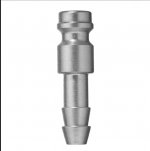4nthony
Member
The chrome quick connect fitting below came off a vacuum pump with what I think is 1/4" ID hose. I want to route some new hose around my workbench and ordered a barbed brass quick connect fitting from McMaster to make an additional connection. The brass should work for what I want to do, but I'd like to learn more about the chrome fitting.

Specs for the McMaster fittings

Based on the McMaster chart, would it be considered European or Compact? I went through the filters on McMaster to try and narrow it down, but a 3/32" tip length is not available for either connection. It's also difficult to find the same barb pattern.

I like that the chrome fittings are much smaller than the industrial brass I purchased.
Thoughts?
- They both have a 5/16" tip but the chrome tip length is 3/32" while the brass is 3/16"
- The chrome barbs are 9/32" while the brass barbs are 11/32"
- The chrome fitting has a flat space between the barbs and stop while the brass barbs continue to the stop

Specs for the McMaster fittings

Based on the McMaster chart, would it be considered European or Compact? I went through the filters on McMaster to try and narrow it down, but a 3/32" tip length is not available for either connection. It's also difficult to find the same barb pattern.

I like that the chrome fittings are much smaller than the industrial brass I purchased.
Thoughts?




